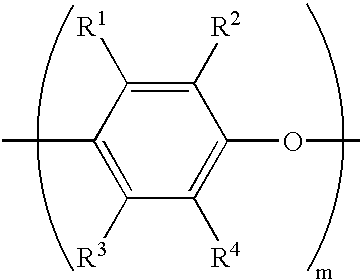Thermoset composition, method, and article
a technology of thermoset and composition, applied in the field of thermoset composition, method, and article, can solve the problem that the low-profile additives known for polyester thermoset are ineffective in the poly (arylene ether)-containing composition, and achieve the effect of reducing its viscosity
- Summary
- Abstract
- Description
- Claims
- Application Information
AI Technical Summary
Benefits of technology
Problems solved by technology
Method used
Image
Examples
examples 8-24
Comparative Examples 2 and 3
[0139] Twenty-five examples and two comparative examples were prepared, varying primarily in the type and amount of polymeric additive. Compositions and properties are summarized in Table 2.
[0140] Two poly(arylene ether) types were used. The poly(arylene ether) designated "50 / 50-0.12 IV PPO-MAA / Styrene" in Table 2 was a 50 weight percent solution in styrene of a methacrylate-capped poly(2,6-dimethyl-1,4-phenylene ether) having an intrinsic viscosity of 0.12 dL / g. The poly(arylene ether) designated "50 / 50-0.12 IV PPO-Psal / Styrene" was a 50 weight percent solution in styrene of a polysalicylate-capped poly(2,6-dimethyl-1,4-phenylene ether) having an intrinsic viscosity of 0.12 dL / g; this material was prepared using the procedure from Example 3 of U.S. Pat. No. 4,760,118 to White et al.
[0141] Several polymeric additives were employed. The additive designated "CTB X162 Hycar" in Table 2 was a carboxy-terminated butadiene homopolymer having a carboxyl content ...
examples 25-30
[0151] Six samples were prepared varying in crosslinker amount, and polymeric additive and amount. The base resin for all samples was a 50 weight percent solution in styrene of a methacrylate-capped poly(2,6-dimethyl-1,4-phenylene ether) having an intrinsic viscosity of 0.12 dL / g.
[0152] The crosslinker was trimethylolpropane triacrylate (TMPTA) or trimethylolpropane trimethacrylate (TMPTMA). The initiator was t-butyl peroxy-2-ethylhexanoate, obtained as LUPEROX.RTM. 26 from Atofina Chemicals.
[0153] Three different polymeric additives were used. The additive designated "PEB Kraton L1203" in Table 3 was a monohydroxy-terminated poly(ethylene-butylene) having a hydroxyl equivalent molecular weight of 4,200 AMU, an approximate hydroxyl functionality of 0.9, and a specific gravity of 0.88 g / cc, obtained as KRATON.RTM. L1203 from Kraton Polymers. "PB Lithene N4-9000" was a liquid polybutadiene having a number average molecular weight of 9,000, 10-20% 1,2 vinyl microstructure, 50-60% trans...
examples 31-36
Comparative Example 4
[0156] Nine compositions were prepared, varying in the amount of polybutadiene and poly(ethylene-butylene) additives. The base resin for all samples was a 50 weight percent solution in styrene of a methacrylate-capped poly(2,6-dimethyl-1,4-phenylene ether) having an intrinsic viscosity of 0.12 dL / g. The crosslinker for all samples was trimethylolpropane trimethacrylate. A polybutadiene having a number average molecular weight of 8,000, and a vinyl content of 28% was obtained as RICON.RTM. 134 from Sartomer. A monohydroxy-terminated poly(ethylene-butylene) copolymer having a hydroxyl equivalent weight of 4,200 and 0.9 hydroxyl functionality was obtained as KRATON.RTM. L1203 from Kraton Polymers. All samples were based on 25% total resin, 54% calcium carbonate, 1% zinc stearate, and 20% 13 millimeter glass fibers.
[0157] Molding was performed at 150.degree. C. and 1,200 psi. Shrinkage, orange peel, and waviness were measured for each sample.
[0158] The results, pres...
PUM
| Property | Measurement | Unit |
|---|---|---|
| glass transition temperature | aaaaa | aaaaa |
| Young's modulus | aaaaa | aaaaa |
| glass transition temperature | aaaaa | aaaaa |
Abstract
Description
Claims
Application Information
 Login to View More
Login to View More - R&D
- Intellectual Property
- Life Sciences
- Materials
- Tech Scout
- Unparalleled Data Quality
- Higher Quality Content
- 60% Fewer Hallucinations
Browse by: Latest US Patents, China's latest patents, Technical Efficacy Thesaurus, Application Domain, Technology Topic, Popular Technical Reports.
© 2025 PatSnap. All rights reserved.Legal|Privacy policy|Modern Slavery Act Transparency Statement|Sitemap|About US| Contact US: help@patsnap.com



